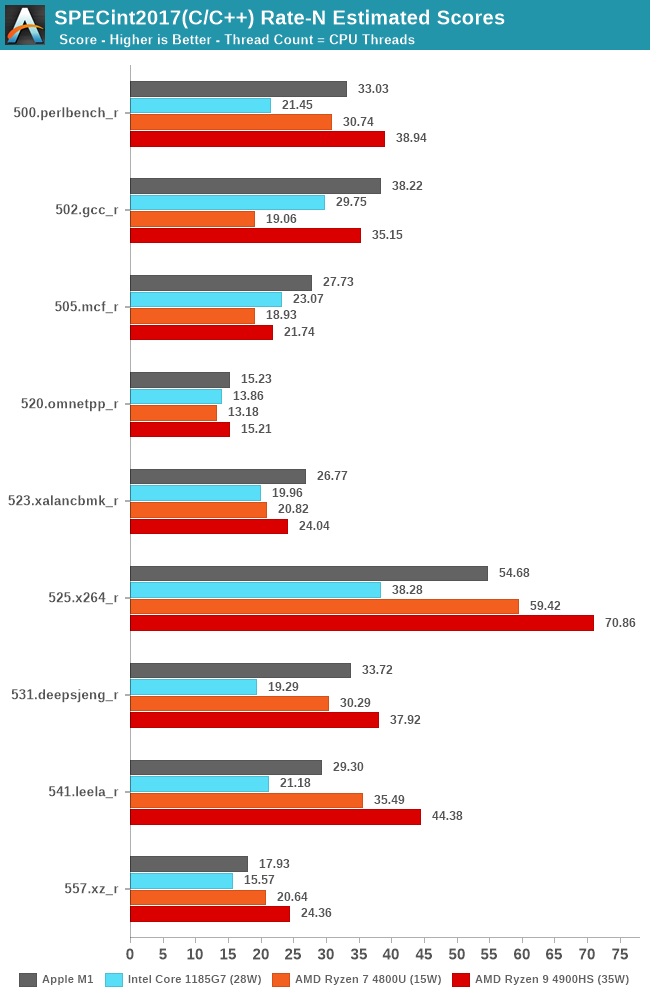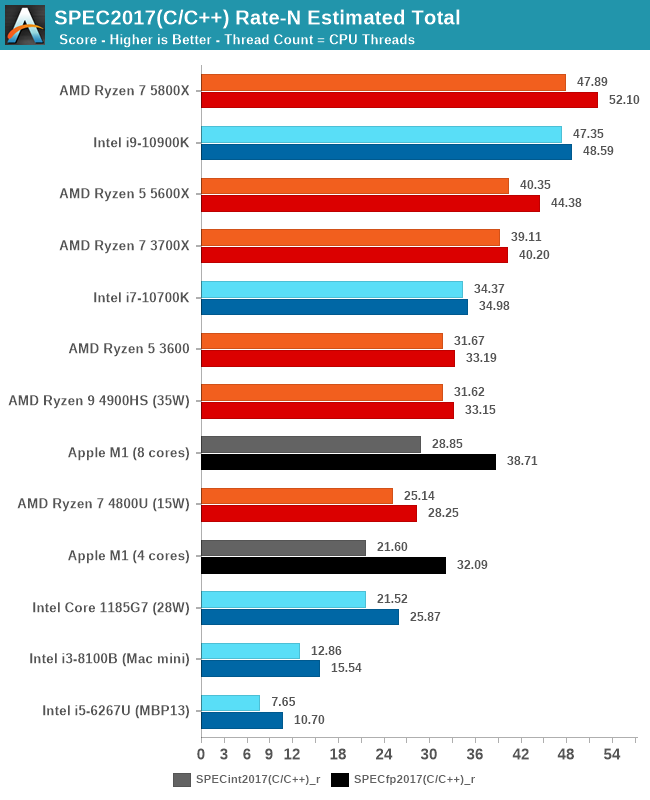The 2020 Mac Mini Unleashed: Putting Apple Silicon M1 To The Test
by Andrei Frumusanu on November 17, 2020 9:00 AM ESTSPEC2017 - Multi-Core Performance
While we knew that the Apple M1 would do extremely well in single-threaded performance, the design’s strengths are also in its power-efficiency which should directly translate to exceptionally good multi-threaded performance in power limited designs. We noted that although Apple doesn’t really publish any TDP figure, we estimate that the M1 here in the Mac mini behaves like a 20-24W TDP chip.
We’re including Intel’s newest Tiger Lake system with an i7-1185G7 at 28W, an AMD Ryzen 7 4800U at 15W, and a Ryzen 9 4900HS at 35W as comparison points. It’s to be noted that the actual power consumption of these devices should exceed that of their advertised TDPs, as it doesn’t account for DRAM or VRMs.

In SPECint2017 rate, the Apple M1 battles with AMD’s chipsets, with the results differing depending on the workload, sometimes winning, sometimes losing.

In the fp2017 rate results, we see similar results, with the Apple M1 battling it out with AMD’s higher-end laptop chip, able to beat the lower TDP part and clearly stay ahead of Intel’s design.

In the overall multi-core scores, the Apple M1 is extremely impressive. On integer workloads, it still seems that AMD’s more recent Renoir-based designs beat the M1 in performance, but only in the integer workloads and at a notably higher TDP and power consumption.
Apple’s lead against Intel’s Tiger Lake SoC at 28W here is indisputable, and shows the reason as to why Apple chose to abandon their long-term silicon partner of 15 years. The M1 not only beats the best Intel has to offer in this market-segment, but does so at less power.
I also included multi-threaded scores of the M1 when ignoring the 4 efficiency cores of the system. Here although it’s an “8-core” design, the heterogeneous nature of the CPUs means that performance is lop-sided towards the big cores. That doesn’t mean that the efficiency cores are absolutely weak: Using them still increases total throughput by 20-33%, depending on the workload, favouring compute-heavy tasks.
Overall, Apple doesn’t just deliver a viable silicon alternative to AMD and Intel, but actually something that’s well outperforms them both in absolute performance as well as power efficiency. Naturally, in higher power-level, higher-core count systems, the M1 can’t keep up to AMD and Intel designs, but that’s something Apple likely will want to address with subsequent designs in that category over the next 2 years.










682 Comments
View All Comments
Eric S - Tuesday, November 17, 2020 - link
That cash is the reason Apple is getting so much of the 5 nm node production.varase - Wednesday, November 25, 2020 - link
You can pretty much forget Microsoft - there is no compelling ARM Microsoft software, and if ARM Windows does do x86 transcompiling it will almost certain be to the standard ARM instruction set, or worse to a Microsoft/Qualcomm mutated instruction set. In no case would it be the Apple SIlicon's AArch64 implantation.If they relied on interpretation instead of trans compilation, expect performance to be less than stellar.
Now Parallels seems to be working on something that they're keeping pretty mum about - my guess would be a hypervisor running x64 clients. Using Rosetta 2 like trans compilation, they could front end OS boot and segment loaders and read x64 code segments and return Apple Silicon AArch64 code to the client virtual machine. They'd probably have to front end code signing segments if those exist. To sustain performance, they'd also have to cache transcompiled code using a source/CRC/length key to prevent having to transcompile all the code all the time.
They wouldn't have Metal access to GPUs to lean back on, so unless Apple implements PCIe attached graphic cards I wouldn't expect gaming to ever be performant enough to be practical.
hlovatt - Tuesday, November 17, 2020 - link
Isn't the 22 W you quote for Apple for the whole system, whereas the 25 W you quote for AMD is just the processor? In't a 10 W Apple processor competitive with a 25 W AMD processor?halo37253 - Wednesday, November 18, 2020 - link
No thats full system power from the wall of AMD's 4800u in 15watt mode.whatthe123 - Tuesday, November 17, 2020 - link
By anandtech's standards these benchmarks are highly misleading, though. 5950x is capped off to its lowest possible package power. In MT testing they switch back to zen 2 chips also power limited. Everything is focusing on efficiency, which is admittedly very, very good, but the article frames it as though these are stock comparisons, when in reality most of these CPUs would be able to draw more power and dwarf the M1 in performance.If they are only looking at efficiency, why make such a misleading article? Just focus on efficiency and the results are stellar. Instead they went with this mess of an article, I'm honestly shocked considering this site normally tries to be unbiased as possible.
Spunjji - Thursday, November 19, 2020 - link
@whatthe123 - "5950x is capped off to its lowest possible package power" - where did you get that impression from?Spunjji - Thursday, November 19, 2020 - link
@whatthe123 - Regarding your complaint that they only compare the 5950X to the M1 in ST testing, of course they do, it's a 16-core 32-thread chip with a 105W TDP and ~140W power limit. It'll demolish the ~24W 4+4 M1 in MT. That's just... not a useful comparison.The point is to show AMD's peak Zen 3 performance against Apple's peak Firestorm performance. Once AMD have Zen 3 processors in the ~25W range, then a valid MT comparison in comparable designs can be made.
helpmeoutnow - Thursday, November 26, 2020 - link
@Spunjji but be fair we want to see the difference between this M1 and fully utilized 5950X just to see the real difference. Now it looks like m1 is a good cpu. but as it is said, they just cap everything else.Stephen_L - Tuesday, November 17, 2020 - link
Nah, no just listen to op, we HAVE to compare chips on the same node! Let’s wait for Intel 7nm also, hopefully in 2022 but god knows if they can do it before 2024, so we can have “Apples to apples comparison”. Let’s come back in 2-4 years guys. /smagreen - Tuesday, November 24, 2020 - link
Totally agree. The Cyrix M3 Jalapeno when it comes out on 5nm is going to crush this little M1.